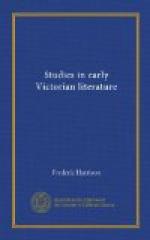Viewed as an historical poem, the French Revolution is a splendid creation. Its passion, energy, colour, and vast prodigality of ineffaceable pictures place it undoubtedly at the head of all the pictorial histories of modern times. And the dramatic rapidity of its action, and the inexhaustible contrasts of its scenes and tableaux—things which so fatally pervert its truthfulness as authentic history—immensely heighten the effect of the poem on the reader’s mind. Not that Carlyle was capable of deliberately manufacturing an historical romance in the mendacious way of Thiers and Lamartine. But, having resolved to cast the cataclysm of 1789 and the few years before and after it into a dramatic poem, he inevitably, and no doubt unconsciously, treated certain incidents and certain men with a poet’s license or with a distorted vision. This too is more apparent toward the close of his work, when he begins to show signs of fatigue and exhaustion. Nay, it is to be feared that we are still suffering from the outrage committed on Victorian literature by Mr. Mill’s incendiary housemaid. We may yet note marks of arson in the restored volume. At the same time, there are large parts of his work which are as true historically as they are poetically brilliant. Part I.—“The Bastille”—is almost perfect. The whole description of Versailles, its court, and government, of the effervescence of Paris—from the death of Louis XV. to the capture of Versailles—is both powerful and true. Part II.—“The Constitution”—is the weakest part of the whole from the point of view of accurate history. And Part III.—“The Terror”—is only trustworthy in separate pictures and episodes, however splendid its dramatic power.
It would need an essay, or rather a volume, on the French Revolution to enumerate all the wrong judgments and fallacies of Carlyle’s book, if we bring it to the bar of sober and authentic history. First and foremost comes his fundamental misconception that the Revolution was an anarchical outburst against corruption and oppression, instead of being, as it was, the systematic foundation of a new order of society. Again, he takes it to be a purely French, local, and political movement, instead of seeing that it was an European, social, spiritual movement toward a more humane civilisation. And next, he regards the Revolution as taking place in the six years between




